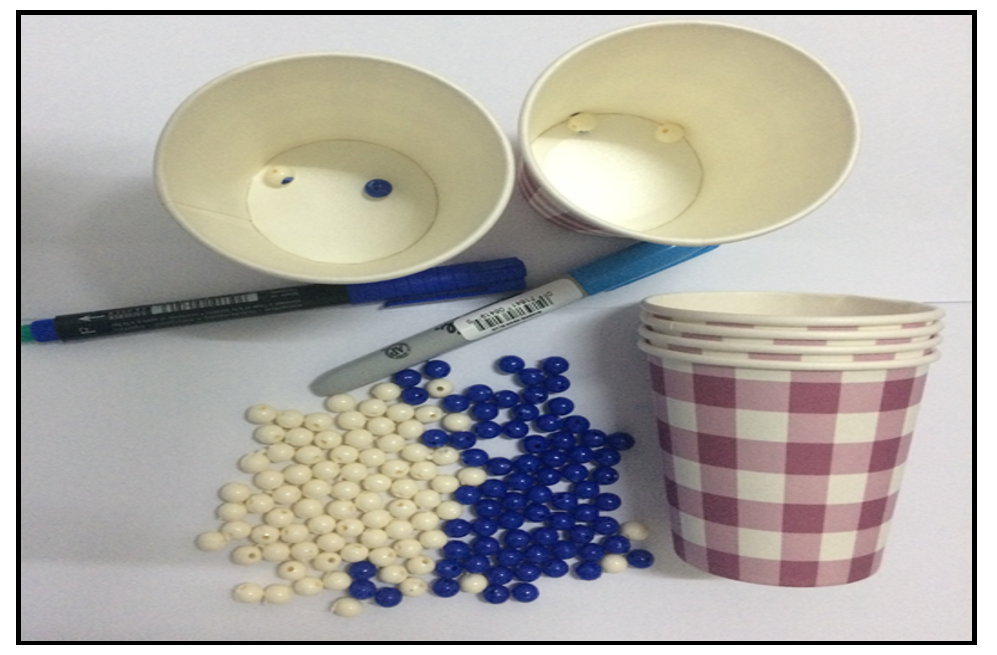การพัฒนาผลสัมฤทธิ์ทางการเรียนเรื่องการถ่ายทอดยีนที่อยู่บนโครโมโซมเพศด้วยกิจกรรมการลงมือปฏิบัติบนฐานการสืบเสาะวิทยาศาสตร์
Main Article Content
บทคัดย่อ
งานวิจัยนี้มีวัตถุประสงค์เพื่อ 1) ตรวจสอบประสิทธิภาพ (E1/E2) และประสิทธิผล (E.I.) ของกิจกรรมการเรียนรู้แบบการลงมือปฏิบัติบนฐานการสืบเสาะวิทยาศาสตร์ เรื่องการถ่ายทอดยีนที่อยู่บนโครโมโซมเพศ
2) ตรวจสอบความก้าวหน้าทางการเรียน (<g>) ของนักเรียน และ 3) เปรียบเทียบผลสัมฤทธิ์ทางการเรียนก่อนเรียนและหลังเรียนของนักเรียน ระเบียบวิธีวิจัยประกอบด้วย 1) การพัฒนาแบบวัดผลสัมฤทธิ์ทางการเรียนชนิดเลือกตอบ 4 ตัวเลือก จำนวน 11 ข้อ 2) การพัฒนากิจกรรมการเรียนรู้แบบการลงมือปฏิบัติบนฐานการสืบเสาะวิทยาศาสตร์ เวลาในการจัดกิจกรรม 150 นาที และ 3) การนำไปใช้กับกลุ่มตัวอย่างนักเรียนชั้นมัธยมศึกษาปีที่ 6 จำนวน 35 คน ที่ได้มาโดยการสุ่มแบบกลุ่ม เก็บข้อมูลจากแบบวัดผลสัมฤทธิ์ทางการเรียนก่อนเรียนและหลังเรียน และใบงาน วิเคราะห์ข้อมูลประสิทธิภาพและประสิทธิผลของกิจกรรมการเรียนรู้ ความก้าวหน้าทางการเรียนของนักเรียน รวมทั้งผลสัมฤทธิ์ทางการเรียนก่อนเรียนและหลังเรียนของนักเรียน ผลการวิจัยพบว่า 1) ประสิทธิภาพและประสิทธิผลของกิจกรรมการเรียนรู้มีค่าเท่ากับ 87.34/83.64 และ 0.77 ตามลำดับ 2) ความก้าวหน้าทางการเรียนของนักเรียนคิดเป็นร้อยละ 77.17 (<g> = 0.7717) จัดเป็นความก้าวหน้าในระดับสูง และ 3) ผลสัมฤทธิ์ทางการเรียนของนักเรียนหลังเรียนอยู่ในระดับดีเยี่ยม (83.64%) ซึ่งสูงกว่าผลสัมฤทธิ์ทางการเรียนก่อนเรียน (28.31%, ระดับไม่ผ่านเกณฑ์ขั้นต่ำ) (p < .05) สรุปได้ว่ากิจกรรมการเรียนรู้นี้สามารถพัฒนาผลสัมฤทธิ์ทางการเรียนของนักเรียนได้
Article Details
วารสารวิทยาศาสตร์และวิทยาศาสตร์ศึกษา (JSSE) เป็นผู้ถือลิสิทธิ์บทความทุกบทความที่เผยแพร่ใน JSSE นี้ ทั้งนี้ ผู้เขียนจะต้องส่งแบบโอนลิขสิทธิ์บทความฉบับที่มีรายมือชื่อของผู้เขียนหลักหรือผู้ที่ได้รับมอบอำนาจแทนผู้เขียนทุกนให้กับ JSSE ก่อนที่บทความจะมีการเผยแพร่ผ่านเว็บไซต์ของวารสาร
แบบโอนลิขสิทธิ์บทความ (Copyright Transfer Form)
ทางวารสาร JSSE ได้กำหนดให้มีการกรอกแบบโอนลิขสิทธิ์บทความให้ครบถ้วนและส่งมายังกองบรรณาธิการในข้อมูลเสริม (supplementary data) พร้อมกับนิพนธ์ต้นฉบับ (manuscript) ที่ส่งมาขอรับการตีพิมพ์ ทั้งนี้ ผู้เขียนหลัก (corresponding authors) หรือผู้รับมอบอำนาจ (ในฐานะตัวแทนของผู้เขียนทุกคน) สามารถดำเนินการโอนลิขสิทธิ์บทความแทนผู้เขียนทั้งหมดได้ ซึ่งสามารถอัพโหลดไฟล์บทความต้นฉบับ (Manuscript) และไฟล์แบบโอนลิขสิทธิ์บทความ (Copyright Transfer Form) ในเมนู “Upload Submission” ดังนี้
1. อัพโหลดไฟล์บทความต้นฉบับ (Manuscript) ในเมนูย่อย Article Component > Article Text
2. อัพโหลดไฟล์แบบโอนลิขสิทธิ์บทความ (Copyright Transfer Form) ในเมนูย่อย Article Component > Other
ดาวน์โหลด ไฟล์แบบโอนลิขสิทธิ์บทความ (Copyright Transfer Form)
เอกสารอ้างอิง
วรวุฒิ ศรีโพธิ์ และสุภาพร พรไตร. (2557). การจำลองพันธุศาสตร์ของมังกร: กิจกรรมเพื่อการจัดการเรียนรู้การถ่ายทอดลักษณะทางพันธุกรรม. วารสารหน่วยวิจัยวิทยาศาสตร์ เทคโนโลยี และสิ่งแวดล้อมเพื่อการเรียนรู้, 5(2), 118-127.
สถาบันส่งเสริมการสอนวิทยาศาสตร์และเทคโนโลยี. (2554). หนังสือเรียนรายวิชาเพิ่มเติม ชีววิทยา เล่ม 4 กลุ่มสาระการเรียนรู้วิทยาศาสตร์. กรุงเทพฯ: โรงพิมพ์องค์การค้าของ สกสค. (ลาดพร้าว).
สุชาดา พ่อไชยราช และสุภาพร พรไตร. (2558). การยกระดับความสามารถด้านการคิดวิเคราะห์ด้วยการจัดการเรียนรู้แบบสืบเสาะวิทยาศาสตร์. วารสารหน่วยวิจัยวิทยาศาสตร์ เทคโนโลยี และสิ่งแวดล้อมเพื่อการเรียนรู้, 6(1), 46-56.
สุภาพร พรไตร. (2558). การเรียนรู้เรื่องวัฏจักรเซลล์และไมโทซิสด้วยการสืบเสาะวิทยาศาสตร์: แนวทางเชิงรุกเพื่อเพิ่มผลสัมฤทธิ์ทางการเรียนและความคงทนของความรู้. วารสารหน่วยวิจัยวิทยาศาสตร์ เทคโนโลยี และสิ่งแวดล้อมเพื่อการเรียนรู้, 6(2), 175-187.
สุภาพร พรไตร. (2559). การเรียนรู้วัฏจักรเครบส์ในการสลายสารอาหารระดับเซลล์ด้วยการสืบเสาะวิทยาศาสตร์: กิจกรรมการลงมือปฏิบัติ (hands-on) เพื่อยกระดับผลสัมฤทธิ์ทางการเรียน. วารสารหน่วยวิจัยวิทยาศาสตร์ เทคโนโลยี และสิ่งแวดล้อมเพื่อการเรียนรู้, 7(2), 285-297.
Allchin, D. (2000). Mending Mendelism. The American Biology Teacher, 62, 633-639.
Boomer, S. M. and Latham, K. L. (2011). Manipulatives-based laboratory for major’s biology a hands-on approach to understanding respiration and photosynthesis. Journal of Microbiology and Biology Education, 12(2), 127-134.
Bybee, R. W., Taylor, J. A., Gardner, A., Scotter, P.V., Powel, J.C., Westbrook, A. and Landes, N. (2006). The BSCS 5E instructional model: origins and effectiveness. A report prepared for the office of science education national institute of health.
Chinnici, J. P., Yue, J. W. and Kierom, M. T. (2004). Students as “human chromosome” in role-playing mitosis and meiosis. The American Biology Teacher, 66(1), 35-39.
Dunlap, D. and Patrick, P. (2012). The beads of translation: Using beads to translate mRNA into a polypeptide bracelet. The American Biology Teacher, 74(4), 262-265.
Gelbart, H. and Yarden, A. (2006). Learning genetics through an authentic research simulation in bioinformation. Journal of Biological Education, 30(3), 107-112.
Hake, R. R. (1998). Interactive-engagement versus traditional methods: a six-thousand-student survey of Mechanics test data for introductory physics courses. American Journal of Physics, 66(1), 64–74.
Lewis, J. and Wood-Robinson, C. (2000). Genes, chromosomes, cell division and inheritance–Do students see any relationship. International Journal of Science Education, 22, 177-195.
Mills Shaw, R.K., Horne, V.K., Zhang, H. and Boughman, J. (2008). Essay content reveals misconception of high school students in genetics content. Genetic, 178, 1157-1168.
National Research Council [NRC]. (2000). Inquiry and the National Science Education Standards: A Guide for Teaching and Learning. Washington D.C.: National Academy.
Saka, A., Cerrah, L., Akdeniz, A. R. and Ayas, A. (2006). A crossage study of the understanding of three genetic concepts: How do they image the gene, DNA and chromosome? The Journal of Science Education and Technology, 15(2), 192-202.
Smith, M. U. (2014a). It’s not your Grandmother’s Genetics Anymore! (Part 1). The American Biology Teacher, 76(4), 224-229.
Smith, M. U. (2014b). It’s not your Grandmother’s Genetics Anymore! (Part 2). The American Biology Teacher, 76(5), 306-310.
Stavroulakis, A. M. (2005). Meio-socks & other genetic yarns. The American Biology Teacher, 67(4), 233-238.
Synder, J. (2008). It’s all in the bag: A genetics activity. The American Biology Teacher, 70(6), 357-362.
Tsui, C. Y. and Treagust, D. F. (2007). Understanding genetics: Analysis of secondary school students’ conceptual status. Journal of research in Science Teaching, 44, 205-235.


